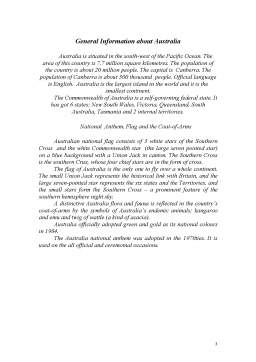Cuprins
- General information about Australia 3
- National anthem, flag and the coat-of-arms 3
- Terra Incognita (Unknown land) 4
- First European settlement 4
- Creation of the Commonwealth of Australia 5
- New crown colonies 5
- Australia’s ties with Great Britain and the USA 6
- Literature 8
Extras din referat
General Information about Australia
Australia is situated in the south-west of the Pacific Ocean. The area of this country is 7,7 million square kilometres. The population of the country is about 20 million people. The capital is Canberra. The population of Canberra is about 300 thousand people. Official language is English. Australia is the largest island in the world and it is the smallest continent.
The Commonwealth of Australia is a self-governing federal state. It has got 6 states: New South Wales, Victoria, Queensland, South Australia, Tasmania and 2 internal territories.
National Anthem, Flag and the Coat-of-Arms
Australian national flag consists of 5 white stars of the Southern Cross and the white Commonwealth star (the large seven pointed star) on a blue background with a Union Jack in canton. The Southern Cross is the southern Crux, whose four chief stars are in the form of cross.
The flag of Australia is the only one to fly over a whole continent. The small Union Jack represents the historical link with Britain, and the large seven-pointed star represents the six states and the Territories, and the small stars form the Southern Cross – a prominent feature of the southern hemisphere night sky.
A distinctive Australia flora and fauna is reflected in the country’s coat-of-arms by the symbols of Australia’s endemic animals; kangaroo and emu and twig of wattle (a kind of acacia).
Australia officially adopted green and gold as its national colours in 1984.
The Australia national anthem was adopted in the 1970ties. It is used on the all official and ceremonial occasions.
Terra Incognita
(Unknown Land)
It is supposed that Australia’s native inhabitants, the Aborigines, arrived in Australia at least 40,000 years ago. The first Europeans visited the shores of Australia in 1606. The Spanish ship of Luis Vaes de Torres sailed through the strait which now bears his name and separates Australia and Papua New Guinea. In the same year the Dutch ship Duyfken (Little Dove) sailed into the Gulf of Carpentaria. Among later voyagers is Dirk Hartog (1616), who left an inscribed pewter plate (Australia’s most famous early European relic, now in Amsterdam) in Western Australia.
Abel Tasman, Dutch navigator, visited Tasmania, which he named Van Diemen’s Land, in 1642.
The first Englishman to visit the continent was a buccaneer, William Dampier, who landed near King Sound on the northwest coast in 1699.
A second wave of immigration began in 1770, when Captain James Cook, of the British Navy, sighted the east coast of the continent.
Cook had been sent to Tahiti to make astronomical observations and when his mission was completed, he sailed south in Endeavour, circumnavigated New Zealand and headed due west. On April 20, 1770, Cook sighted land near Cape Everard, in the southeast corner of Australia. He turned north, charting the coastline as he went and, 9 days later, landed at Botany Bay, which he named for the variety of botanic specimen found there. He raised the British flag and claimed New South Wales as a British Colony.
First European Settlement
It is probably due to its geographical position that Australia was the last continent to be inhabited by the white man. It was just a little over 390 years that the Australian continent was discovered.
The first landing by Europeans took place in 1606. More than a century and a half later an expedition headed by the British explorer James Cook added the land to the possessions of the British crown.
Until the name “Australia” (meaning “South Land”) became generally accepted for the continent, it had been referred to as New Holland, New South Wales, or Botany Bay. During the War of Independence (1776) the former British colonies in America declared themselves independent. Britain tried to make up for this loss by the seizure of new territories. Besides, the convicts could no longer be transported to the American colonies (which had served this purpose for over hundred years) and British jails were more than badly overcrowded.
Preview document
Conținut arhivă zip
- Australia - A Brief History.doc
















